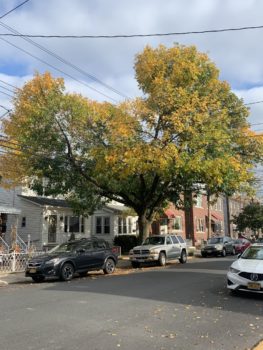
Image Credit: CityLand.
On June 23, 2022, the City Council Committee on Parks and Recreation held an oversight hearing to discuss improving the city’s tree canopy. Chaired by Council Member Shekar Krishnan, representatives from both the Parks Department and local community organizations testified before the committee.
The meeting came off the heels of the City’s Fiscal Year 2023 budget, which includes the largest Parks budget in city history. The budget includes $44 million in capital funding to plant new trees, with an additional $27 million allocated to the maintenance of existing trees.
In his opening statement, Chair Krishnan summed up the committee’s goals in increasing the tree canopy. Trees benefit local communities by fighting climate change, improving air and water quality, and mitigating urban heat, which in turn betters people’s mental and physical health outcomes. Chair Krishnan pointed out inequity in the city’s current tree distribution, emphasizing the need for more trees in marginalized communities. However, Krishnan also highlighted the high amount of Parks-related 311 calls that involve trees. The committee’s bottom line, Krishnan summarized, is that more communities should have trees and those trees should be safe.
Before hearing testimony from urban forestry advocates and other members of the public, the committee questioned Jennifer Greenfeld, the Parks Department’s newly promoted Deputy Commissioner of Environment and Planning.
Greenfeld specifically addressed City Council’s concerns over safety and equitable distribution of new trees. After previously planting trees only when citizens requested them, Parks is now prioritizing underserved communities and areas with extreme heat through a Heat Vulnerability Index. Additionally, Parks looks at each individual 311 complaint for key words about safety, and Greenfeld ensured that if a request is of concern, the tree is inspected right away regardless of its pruning cycle. Several councilmembers, including Council Member Linda Lee of the 23rd District, expressed additional concern over tree roots in sidewalks causing safety issues. Greenfeld stated that $10 million in the Parks budget goes towards trees and sidewalks, actively combatting this problem.
Greenfeld also explained that while 22 percent of the city’s present land cover is trees, advocates are pushing for the tree canopy to increase to 30 percent by 2035. Although there’s potential to meet this goal, Greenfeld pointed out the question of where new trees would go and argued that Parks is not the issue. Currently, 47 percent of the city’s tree canopy is on public or private land, with the rest managed by NYC Parks. While trees account for just 22 percent of land cover citywide, 47 percent of the land cover in city parks is trees. To improve the tree canopy both inside and outside of parkland, Greenfeld believes the city needs “to have a wide ranging effort of both tree preservation and planting”.
Comments from the public echoed this two-pronged approach, with several speakers criticizing City Council for holding an oversight meeting on the issue of tree canopy while actively cutting down existing trees. Residents near the East River Park expressed concern over 700 older trees that were recently cut down, and multiple testimonies called for the increase in tree canopy to 30 percent by 2035. Representatives from various member organizations in Forest for All NYC, a coalition calling for increased tree canopy, also spoke at the oversight meeting, similarly highlighting the benefits of trees and need for equitable distribution.
CityLand will continue to provide updates as the Parks Committee proposes solutions to improve the city’s tree canopy.
By: Cassidy Strong (Cassidy is a CityLaw intern and a New York Law School student, Class of 2024.)
CC: Committee on Parks and Recreation (T2022-1549 June 23, 2022).

